 |
 |
 |
| |
Predictors of Chronic Kidney Disease in the SMART trial
|
| |
| |
Reported by Jules Levin
CROI 2011 March 2 Boston
Jacqueline Neuhaus acquelineNeuha1, Mocroft2, Wyatt3, Ross3, , Amanda Mocroft, Christina Wyatt, and Michael Ross, for the INSIGHT SMART Study Group
2Royal Free and HIV Primary 3Mt. United StatesRoyal Freeand University College Medical School, Royal Free Centre for HIVMedicine and Dept PrimaryCare and Population Sciences, London, United Kingdom, Mt. Sinai School of Medicine, Department of Medicine, New York, United StatesUniversity of Minnesota, Department of Biostatics, Minneapolis, MN, USA,
Continuous viral suppression with ART was associated with lower risk and lower rate to development of new or pregressive CKD in SMART.....In Table 3 HCV coinfection was more prevalent in patients who progressed to End Stage Renal Disease or renal death (55.6% vs 16.9%), so was diabetes (55.6% vs 6.9%) and hypertension (83.3% vs 18.5%), but CD4 counts were the same whether a patient declined to renal death or ESRD (558 vs 597), and age was average 53 in the group experiencing renal death or ESRD vs 43 in those not......The pattern of progression to the CKD endpoint is illustrated in a Kaplan-Meier analysis (Feg 1). Cumulative estimates of progression at 12, 24, and 36 months were 1.6%, 3.4% and 5.4% for the DC group and 0.8%, 2.2% and 3.4% for the VS group (continuous HAART) respectively. And expected risk factors HCV, diabetes, and hypertension also was associated with increased risk for shortened time to developing kidney disease.
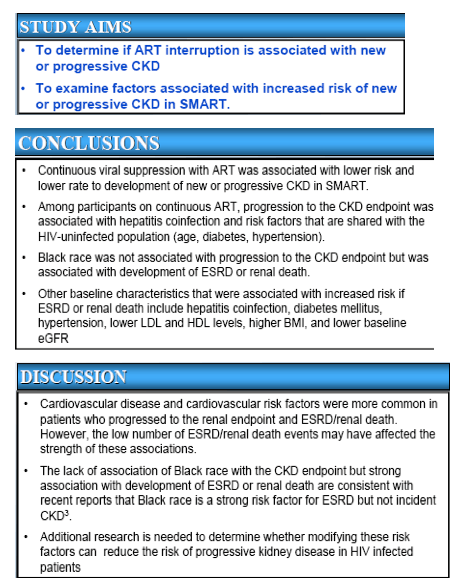
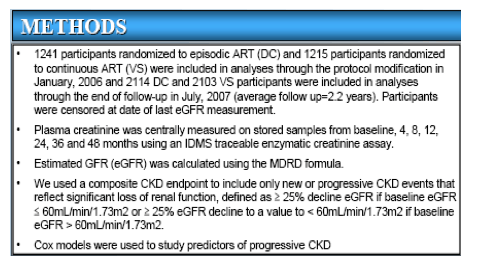
ABSTRACT
Background: Chronic kidney disease (CKD) is an important cause of morbidity and mortality in HIV+ persons. We examined factors associated with increased risk of new or progressive CKD in the Strategies for Management of ART (SMART) trial.
Methods: Plasma creatinine was centrally measured on stored samples using an IDMS traceable enzymatic creatinine assay for 2114 participants assigned episodic ART (DC) and 2103 participants assigned continuous ART (VS) at baseline and during follow-up (average 2.2 years). Estimated glomerular filtration rate (eGFR) was calculated using the MDRD formula. We used a composite CKD endpoint to include only new or progressive CKD events that reflect significant loss of renal function, defined as ≥25% decline eGFR if baseline eGFR ≤60 mL/minute/1.73 m2 or ≥25% eGFR decline to a value of <60 mL/minute/1.73 m2 if baseline eGFR >60 mL/minute/1.73 m2. Cox models were used to study predictors of progressive CKD.
Results: The rate of progression to the CKD endpoint was higher in participants randomized to the DC group (1.8 CKD events/100 person-years) than those in the VS group (1.2 CKD events/100 person-years) [hazard ratio (HR) for DC vs VS = 1.5; p = 0.01]. This HR was 1.6 (p = 0.05) when follow-up was censored at the protocol modification (when DC participants were advised to reinitiate ART) and was 1.4 when restricted to CKD events occurring after protocol modification (p = 0.15). Since continuous ART is now standard of care, baseline factors that were associated with development of the CKD endpoint in the VS group (56 events) were examined. Predictors of decreased time to progression to the CKD endpoint included hepatitis virus co-infection (HR 1.9, p = 0.049), advanced age (HR 1.91/10 years, p <0.001), diabetes (HR 2.5, p = 0.009), and hypertension (defined as treatment with anti-hypertensive medication) (HR 2.4, p = 0.005).
Conclusions: Episodic treatment with ART was associated with higher risk of development of the CKD endpoint in SMART. Among participants on continuous ART, the CKD endpoint was associated with hepatitis co-infection and risk factors that are shared with the HIV-uninfected population (age, diabetes, hypertension).
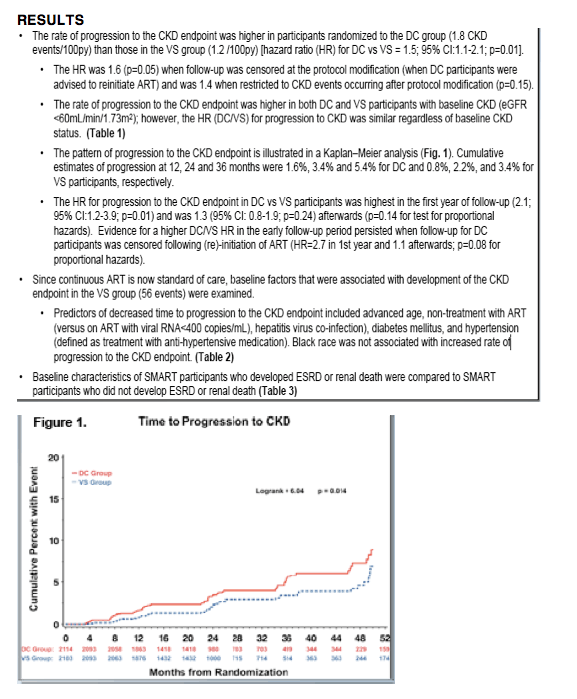
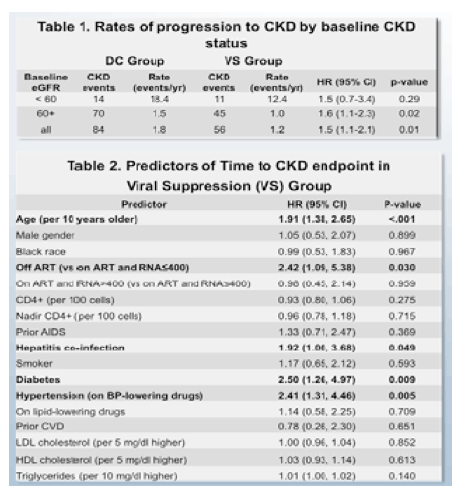
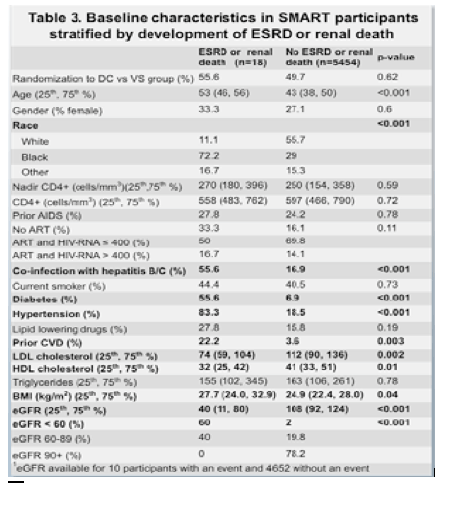
|
| |
|
 |
 |
|
|